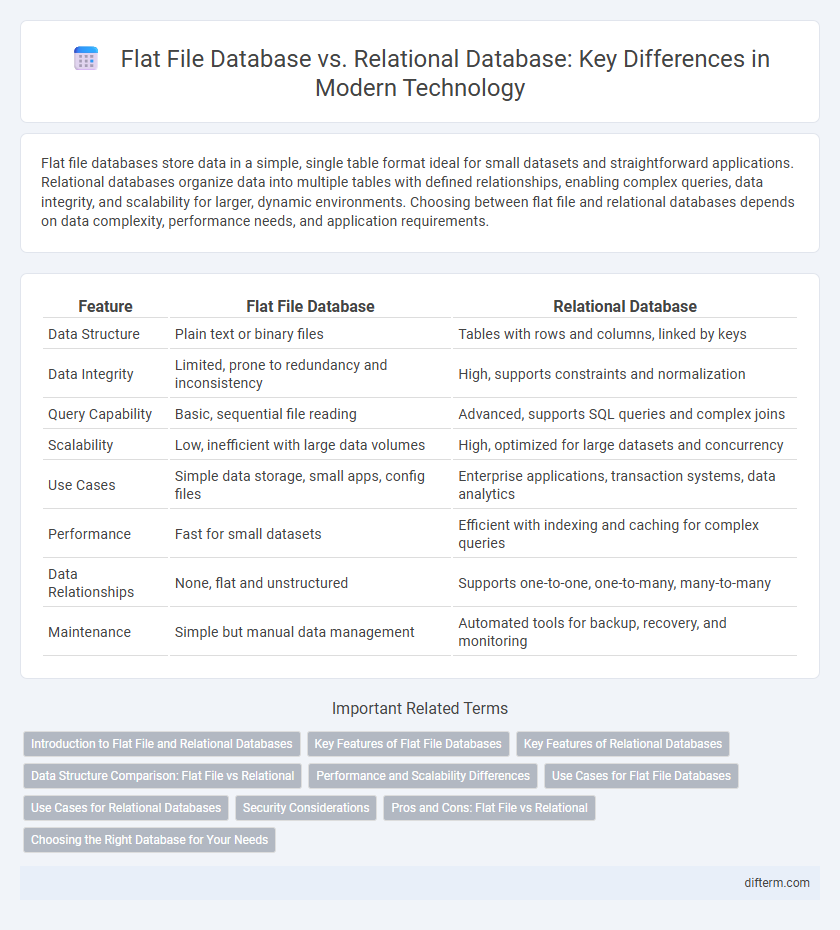Flat file databases store data in a simple, single table format ideal for small datasets and straightforward applications. Relational databases organize data into multiple tables with defined relationships, enabling complex queries, data integrity, and scalability for larger, dynamic environments. Choosing between flat file and relational databases depends on data complexity, performance needs, and application requirements.
Table of Comparison
| Feature | Flat File Database | Relational Database |
|---|---|---|
| Data Structure | Plain text or binary files | Tables with rows and columns, linked by keys |
| Data Integrity | Limited, prone to redundancy and inconsistency | High, supports constraints and normalization |
| Query Capability | Basic, sequential file reading | Advanced, supports SQL queries and complex joins |
| Scalability | Low, inefficient with large data volumes | High, optimized for large datasets and concurrency |
| Use Cases | Simple data storage, small apps, config files | Enterprise applications, transaction systems, data analytics |
| Performance | Fast for small datasets | Efficient with indexing and caching for complex queries |
| Data Relationships | None, flat and unstructured | Supports one-to-one, one-to-many, many-to-many |
| Maintenance | Simple but manual data management | Automated tools for backup, recovery, and monitoring |
Introduction to Flat File and Relational Databases
Flat file databases store data in a single table or file, making them simple and easy to create but limited in handling complex queries or relationships. Relational databases organize data into multiple related tables using keys, enabling efficient data management and powerful querying capabilities through Structured Query Language (SQL). Choosing between flat file and relational databases depends on the complexity of data, scalability needs, and the frequency of data retrieval operations.
Key Features of Flat File Databases
Flat file databases store data in a single table, typically a plain text or CSV file, where each line represents a record and fields are separated by delimiters. They lack complex relationships, indexes, or support for multiple tables, making them simple but less efficient for large datasets or complex queries. Key features include ease of use, portability, and straightforward structure, which suits small-scale applications with minimal data relationships.
Key Features of Relational Databases
Relational databases organize data into tables with predefined schemas, enabling efficient querying through Structured Query Language (SQL). They enforce data integrity using keys such as primary keys for unique identification and foreign keys for establishing relationships between tables. Features like normalization minimize redundancy, while support for transactions ensures data consistency and reliability across complex operations.
Data Structure Comparison: Flat File vs Relational
Flat file databases store data in a single table or plain text file, limiting relationships and scalability, making them suitable for simple, small datasets. Relational databases organize data into multiple tables with defined relationships using keys, enabling complex queries and data integrity through normalization. The structured format of relational databases supports efficient data retrieval and management compared to the flat file's straightforward but less flexible schema.
Performance and Scalability Differences
Flat file databases offer simplicity and faster read operations for small datasets due to their minimal overhead, but they lack indexing and efficient querying capabilities, which hinders performance as data volume grows. Relational databases utilize advanced indexing, query optimization, and normalization techniques, enabling better performance and scalability for large and complex datasets. Scalability challenges in flat file systems stem from sequential data access and redundancy, whereas relational databases handle concurrent access and large-scale data through optimized storage engines and distributed architectures.
Use Cases for Flat File Databases
Flat file databases are ideal for simple, small-scale applications requiring minimal setup and low overhead, such as configuration files, desktop utilities, and single-user data storage scenarios. Their straightforward, text-based format allows for quick access and easy integration in lightweight or embedded systems without complex querying needs. These databases are often preferred in environments where simplicity and speed outweigh scalability and relational data integrity.
Use Cases for Relational Databases
Relational databases excel in handling complex queries and maintaining data integrity across multiple tables, making them ideal for enterprise resource planning (ERP) systems, customer relationship management (CRM) platforms, and financial applications. Their structured schema and support for ACID (Atomicity, Consistency, Isolation, Durability) transactions enable efficient management of large datasets requiring consistency and reliability. Relational databases are preferred for applications where relationships between data entities are critical, such as inventory tracking, order processing, and healthcare record management.
Security Considerations
Flat file databases lack built-in security features, making them vulnerable to unauthorized access and data breaches. Relational databases offer advanced security mechanisms such as user authentication, role-based access control, and encryption to protect sensitive information. Proper implementation of these security measures in relational databases significantly reduces the risk of data leaks and enhances overall data integrity.
Pros and Cons: Flat File vs Relational
Flat file databases offer simplicity and ease of setup, making them ideal for small-scale applications with minimal relational data requirements, but they lack scalability and efficient querying capabilities for complex datasets. Relational databases provide robust data integrity, support for complex queries, and scalability through structured tables and relationships, but they require more setup, maintenance, and computational resources. Choosing between flat file and relational databases depends on factors like data complexity, volume, need for relationships, and performance demands.
Choosing the Right Database for Your Needs
Flat file databases are suitable for small, simple datasets requiring minimal relationships, offering fast access with straightforward structures. Relational databases excel in handling complex data with multiple relationships, ensuring data integrity and scalability through structured query language (SQL) support and normalization. Selecting the right database depends on factors like data complexity, volume, concurrency needs, and long-term scalability requirements.
Flat file database vs Relational database Infographic

 difterm.com
difterm.com